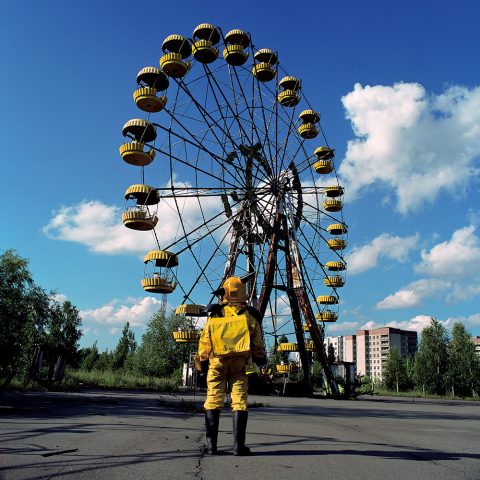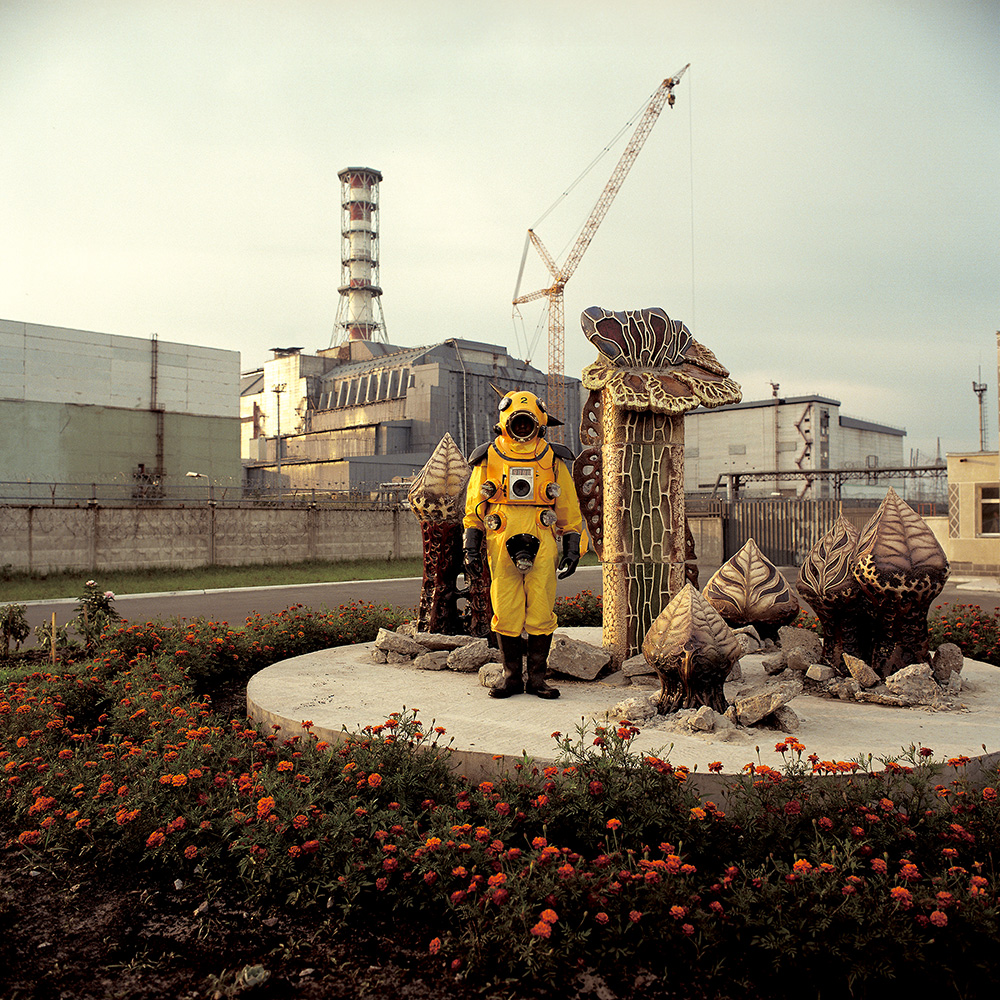
YANOBE KENJI 1969-2005
02 THE TRIP TO CHERNOBYL [1997]
【Chapter 02】1997 THE TRIP TO CHERNOBYL
Yanobe created a series of life-size mechanical sculptures based on the theme of “Survival”. These devices would expand or, at times, exaggerate his functions. At the same time, he built a fortress in the world of art by transforming himself into a dictator in the hypertrophied world of delusion.
He left Japan and went to Berlin, Germany. The mass sarin poisonings in the Tokyo subways and the Hanshin earthquake had occurred in Japan. Suddenly, a mood of fin de siecle arose in the country, and Yanobe began to feel a sense of incongruity toward works that protected only him.
At that time, he finished a new work of art titled Atom Suit. It was a lighter work that represented a change from his previous pieces, which were massive forms made of metal. He used this as the opportunity to burst forth from such exhibition spaces as museums and galleries to the world outside. Yanobe had embarked on a journey to attain a new realization. Still, there was no reason for him to know then that Atom Suit would lead him to an unforeseen world of reality. In that instant, the world of creations enclosed in “Delusion” first came into contact with “Reality”.
THE TRIP TO CHERNOBYL -“Delusion” and “Reality” –
For Yanobe, “Delusion” was the key word that defined his generation. Immersed in television and movies, that generation had lost its sense of reality, washed away by a flood of information. Searching for an expression to typify this experience, he began creating works on the theme of “Survival”. As if he were a dictator who dreamed of expanding his own world of delusion, Yanobe created Nest (for dictators) against the backdrop of the Gulf War (1991), as the first step in the invasion of the world of art. Surveillance equipment, protective devices, threatening devices…Yanobe gave the work real functions as an expression of reality. Yanobe himself played the dictator, using the highly original mechanical sculptures that fit his body size as a means. Based on the theme of World Conquest, the works had an effective presence positioned in the world, not just in a museum or gallery. Yanobe declared they were essential for his life.
This was revealed by “An Eccentric Life of Kenji Yanobe” (1991, Kirin Plaza Osaka), and the one-month long “Yanobe Kenji Paranoia Fortress” (1992, Art Tower Mito) that completed Survival System Train was a blatant display of an exaggeratedly delusional world view. It involved laying rails and operating a train in the museum. Yanobe always was a pioneer in Japanese art.
After his debut as an artist, Yanobe quickly gained the limelight and worked at a feverish pace. He lived in Berlin for three years, starting in 1994. The historical structure of Berlin included the plans for it to be reconstructed as a city of the exaggeratedly delusional Third Reich (the country of the future) under the dictator Hitler, and later The Wall, symbolizing the Cold War between East and West and the division of Germany.
Yanobe left Japan and worked in a rented studio for sculptors while coming face to face himself, as if to recover his spirit. Through work with a Paris gallery, he was involved in a stimulating environment with a dynamic flow of works of contemporary art. While continuing to show his work overseas, Yanobe realized that Japanese pop culture had transcended nationality and was accepted as the core of a shared artistic awareness and universal beauty. But at that time, he began to be gripped by a feeling about his work that the impression it left on people was nothing more than as a set or props for a science fiction film.
The mass sarin poisonings in the Tokyo subways and the Hanshin earthquake occurred in Japan in 1995. For Yanobe, who was in Berlin, the occurrence of these events was as if he were witnessing a real “Survival” or “Delusion” on the television screen. Suddenly, a large wall appeared before Yanobe, blocking his path. By proclaiming World Conquest and the Fortress of Delusion, he wondered if he really needed the work he had continued to create for himself. Was it a mere pipe dream, or wordplay in a museum? Was what he had done as an artist simply a delusion? For Yanobe, who had been unable to sense the reality of “Survival” or “Delusion” when it actually occurred, a new mission was thrust on him in that instant – how to present new acts of expression in the future.
Just at that time, Yanobe acquired the information that an amusement park existed in Chernobyl, which had been turned into a ghost town from the nuclear meltdown that occurred in 1986. Yanobe had an intuition that he must to go there.
“The artist, with his existence as a kind of pioneer, is always trying to go beyond his shell, or his border, or category. I think his approach must be to create something new while seeing how far he can go and going right up to the edge.” Yanobe tried to give a violent jolt of reality to his body that he had enclosed m a creative world using the themes of “Survival” and “Delusion”.
There were still hot spots, high-level radioactive zones, in Chernobyl. It took Yanobe two years to make all the preparations, both filling out the required applications and raising the funds, to enter the enforced evacuation area. This encompassed a 30-kilometer radius from the reactor where the accident occurred. Yanobe reports that he sensed it was kind of holy ground in which people were forbidden to cas叫ly enter. What revelatory experience would change him? Even if it were an act that betrayed his own uniquely delusional generation, Yanobe had resolved to confront “Reality”. Wearing his ATOM SUIT, he entered Chernobyl with a photojournalist who had been there before, as if he were being guided. This was also the start of the Atom Suit Project in 1997.
ATOM SUIT
After Tanking Machine, Yanobe created Yellow Suit in tandem with Nest. This was a sturdy suit for protection against radiation. The exterior was coated with steel and the interior was lined with lead. After the Mihama nuclear accident of 1991,Yanobe hastily created this for himself and his pet dog Kassy.
It was more like armor than a suit, and more of a clothing accessory better suited for museums of natural history than being a work for art museums. To support the weight of the suit itself, its structure had a balance scale type of structure connected to a device for creating oxygen by photosynthesis. Therefore, he could not move as freely as he wished. Ironically, the result was that he could only obtain a living space about two meters wide, which corresponded to the size of the balance scale. This, however, led to the creation of Atom Suit.
To the chest of the suit, Yanobe attached a Geiger counter that responded to natural radiation. Whenever it detected radiation, it emitted a flash of light and a sound, and registered the amount. He sensed a mysterious attraction in the device, as if it were creating a visual representation of Mother Nature. He incorporated it for the first time in Yellow Suit. The use of the Geiger counter provided a sense of reality to Yellow Suit work itself. At the same time, there was an amazing sense of life, as if the suit spoke on its own even if Yanobe didn’t wear it. The Geiger counter was the oldest device for detecting radiation, having been developed by Geiger and MUller in 1928. Radiation is a form of energy.
It is invisible and odorless, and it does not cause pain or itching. One quality characteristic of radiation is its permeability. It passes through everything, and is not obstructed by buildings. Attaching to the body a device to detect this amazing power might show what happens when radiation passes through the body. Yanobe began to build a new suit that would detect radiation while quoting Astro Boy, the atomic-powered robot who symbolized the age. His first creation, Radiation Suit Atom, borrowed the design from Astro Boy, with two black horns, a green belt, and red boots. It had an unusual form that resembled a balloon doll. After that, Yanobe emphasized performance that would actually protect the body.
To protect both the surface and the interior of the human body from radiat10n, requires clothing, masks, gloves and other accessories to prevent the body from coming in contact the outside air. As a means to deal with atomic accidents that actually occur, it would be most effective to protect the body from radiation if the adhered radioactive substance could be discovered as quickly as possible, cleaned, and distance established between oneself and the radioactive source.
The radiation detection suit evolved more advanced. Yanobe attached a Geiger counter to the important parts of the human body, including the eyes, reproductive organs, and other organs, and gave the suit a waterproof function that enabled radiation to be washed from the body. He also made it in a form in which people could easily move around. The finished result was the yellow Atom Suit.
Yanobe wore Atom Suit and headed for Chernobyl. As with an astronaut wearing a space suit, or a diver wearing a diving suit to immerse himself in the sea, Yanobe wore a suit with the minimum functions to protect his life. He did this to go from the display spaces of a museum or gallery, recover a sense of reality missing from his person, and transform himself again. For Yanobe, who was to discover his own expressive act and a point of contact with society, Atom Suit was another layer of skin.
Wearing Atom Suit and going to Chernobyl was the first step from “Delusion” to “Reality”. It was such an important turning point that it transformed all his works to that point as well as Yanobe himself.
Yanobe added four photographs from the Atom Suit Project at Chernobyl to his solo exhibition, which at that time was in San Francisco. The scene of the photographs illuminated in a light box began to cast the shadow of “Reality” over his previous works, with which they were displayed. These scenes were created from the falsehood of “Delusion”, and the works in which his confidence wavered began to establish a solid presence. Yanobe made absolutely sure of that with his own body.
